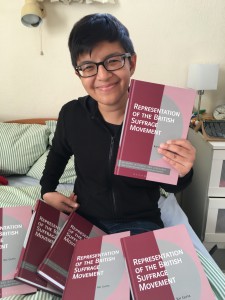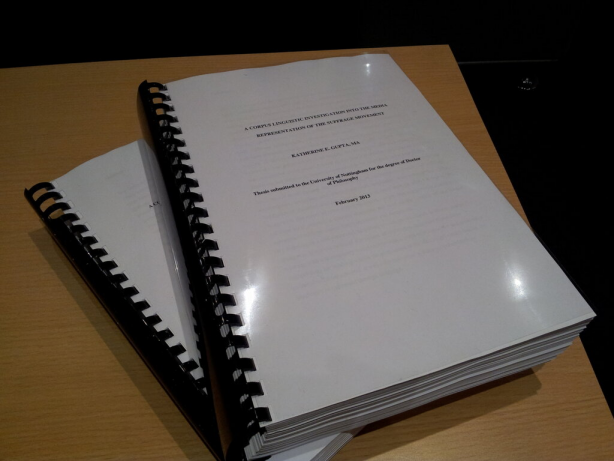It’s a busy time in the world of Kat! I finished my marking a couple of weeks ago (horror, despair, consumption of an inadvisable amount of chocolate hobnobs) and since then it’s been trying to beat my thesis into shape. Add to that family illness and a sick pet, and well. I’m sure you can imagine.
One of the things I’ve found most difficult about my thesis is reconciling a data-driven approach with theory. My instinct is to let the data guide me as much as possible rather than approaching the data with the expectation of finding something if I look at a particular, pre-selected word. On a methodological level, I’ve found looking at mutual information really useful because it shows links between words that aren’t necessarily obvious but often worth further investigation. This is especially true of the texts I’m working with. While suffrage-produced texts have been studied closely by lots of people, newspaper reporting and discussion of the suffrage movement isn’t something that’s been researched in depth. I’ve tried to let myself go of assumptions about whether or not they’ll behave like suffrage-produced texts. In some ways, letting go of the conviction that they’d be radically different is harder – every researcher wants to find something completely new, after all! However, as Lesley Hall might say, “it’s always more complicated”.
In my first year I tried to learn as much as possible about early 20th century British history so I could contextualise my data. Instead of looking at it simply as machine-readable data, I can recognise the discourse it draws upon – that of separate spheres for men and women, the effect engaging in public life was thought to have on women, ideas about who should choose a government of Empire. I’ve found evidence of these in the Times texts I work with and it’s been exciting to find these – little moments where things click into place, where the historiography and the data align. Bringing together these two fields has been rewarding and I hope my research is better for it.
Critical Discourse Analysis (CDA) and I, however, are a different story. I’m sure at one point I could do Critical Discourse Analysis – indeed, I got a 75 for a CDA essay as an undergraduate. I like the concepts underlying it – after all, recognising ideologies, examining power relations, questioning assumptions and destabilising cultural hegemony is interesting, not to mention very relevant to my research. However, I’ve realised that one of my problems lies with the nature of the texts I work with. Analysis of news discourse – things like newspapers, TV, radio – seems to rely on some assumptions about how news discourses are organised. For example, one theme that recurs in analysis of (written) news discourse is that news texts are organised by importance rather than chronologically. This means that you can read the headline and first paragraph of a news story and have a pretty good idea of what the news story is about.
Here’s a news text selected at more-or-less random. The headline, “US teen survives spear through brain” and first sentence, “A US teenager’s survival after a spear was shot through his brain is a miracle, doctors say” answer a lot of the “wh- questions”:
Who? A US teenager
What? Survived being shot through the brain with a spear; doctors say it’s a miracle.
Where? In the US
The next sentence, “Yasser Lopez, 16, is recovering after he was accidentally hit with a spear gun by a friend during a Florida fishing trip this month” answers some more of these questions:
When? This month
How? Accidentally hit with a spear gun by a friend.
Most of the key information is contained in the headline and these two sentences – you could read this much in a news in brief article and it would make sense. At the article continues, the information offered becomes more detailed and less “key” to understanding the news story. By the end of the article, we’re getting information about which part of his brain the spear passed through. Obviously this is a pretty basic analysis and looking at moves in news discourse can be much more elaborate.
However, what do you do when even these basic tenets of news discourse – that information is organised in terms of importance rather than chronologically – cannot be relied on? One of the ways early 20th century news texts are different from present day news texts is that they are often organised chronologically. In fact, quite a lot of assumptions about news discourse don’t work when it comes to these texts – after all, this was a period when printing 17,500 word Parliamentary transcripts in the Times was normal.
The style of CDA I’m going with, therefore, is not entirely news discourse analysis. And, having thought about it in the writing of this post, I’m okay with that. That a big chunk of news discourse analysis doesn’t work for me isn’t a failure on my part, but demonstrate that my texts are, once again, doing something different. This is okay, and in fact something interesting to add to my discussion of CDA.
Anyway, at the moment I’m in Leeds for IVACS. Some people are presenting using data from Old Bailey Online which sounds fascinating – historical forensic linguistics and corpus linguistics? Sounds good to me.





